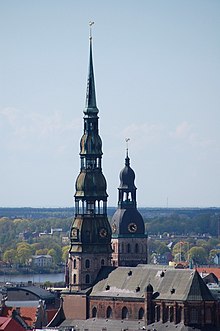St. Peter's Church, Riga
| St. Peter's Church | |
|---|---|
| Svētā Pētera baznīca | |

St. Peter's Church, with the tower of the cathedral church behind
|
|
| 56°56′51″N 24°6′34″E / 56.94750°N 24.10944°ECoordinates: 56°56′51″N 24°6′34″E / 56.94750°N 24.10944°E | |
| Location | Riga |
| Country | Latvia |
| Denomination | Lutheran |
| Previous denomination | Roman Catholic |
| Website | Website of the Church |
St. Peter's Church (Latvian: Svētā Pētera Evaņģēliski luteriskā baznīca) is a Lutheran church in Riga, the capital of Latvia, dedicated to Saint Peter. It is a parish church of the Evangelical Lutheran Church of Latvia.
First mention of the St. Peter's Church is in records dating to 1209. The church was a masonry construction and therefore undamaged by a city fire in Riga that year. The history of the church can be divided into three distinct periods: two associated with Gothic and Romanesque building styles, the third with the early Baroque period. The middle section of the church was built during the 13th century, which encompasses the first period. The only remnants of this period are located in the outer nave walls and on the inside of a few pillars in the nave, around which larger pillars were later built.
The second period dates to 1408–09, when master builders Johannes Rumeschottel from supervised the construction of the sanctuary, based on the in Rostock. The sanctuary was almost finished by 1409, but due to the Polish–Lithuanian–Teutonic War it was completed and dedicated only in 1419. Other construction work was interrupted by the plague in 1420 and resumed in the 1430s. The 13th-century church was reconstructed in 1456–66 to conform to the newly built sanctuary. Both constructions were joined in the 1470s, thereby creating a mighty basilica with three aisles and ornate vaulted ceilings. The old bell tower was replaced in 1456, and a bell was hung in the new tower in 1477. A 136 metres (446 ft) octagonal steeple was added to the tower in 1491, which, along with the church's front facade, dominated the silhouette of Riga. The tower collapsed 11 March 1666, destroying a neighboring building and burying eight people in the rubble. The cornerstone for a new tower was laid 29 June 1667.
...
Wikipedia

